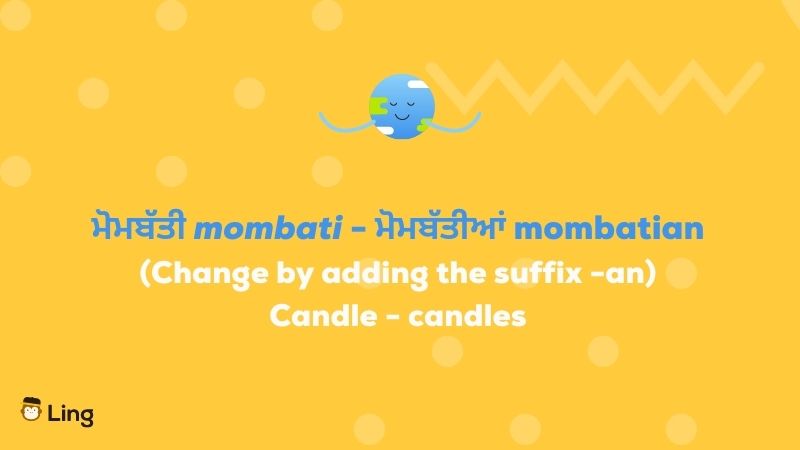The word “Punjabi” is an adjective or a noun that refers to something or someone from the Punjab region. In English, the plural form of “Punjabi” would be “Punjabis.” It refers to more than one person from the Punjab region. That sounds like a pretty easy grammar point to consider, right? Well, here is the thing: Making Punjabi words plural is a different story entirely! Let’s take a look.
In the Punjabi language, words can be made plural by adding the suffix “-an” to the end of the term. For example, “book” would become “book-an” in the plural form. Using a Punjabi word, a candle is ਮੋਮਬੱਤੀ mombati, which will become ਮੋਮਬੱਤੀਆਂ mombati-an. Simple, right? In this post, we will look at several more examples of these, and I’ll also help you understand how irregular plural forms in Punjabi may differ. In Punjabi, certain words do not have a plural form, such as nouns already in the plural form.
A perfect example is “parents” or “clothes” and uncountable nouns such as “water” or “milk.” Also, words that denote an idea or a concept, like “love” or “truth,” fall in the same category and don’t have a plural version. These words are considered always be
Let’s start!

Rules On Making Punjabi Words Plural
In the Punjabi language, there are a few different ways to form plurals, depending on the word. standard rules and Punjabi pronunciation include:
- Adding the suffix “-an” to the end of the term word as mentioned above.
- Changing the vowel sound at the end of a word, as in ਬੱਚਾ baccha (child) becoming ਬੱਚੇ bache (children).
- Using a completely different word to indicate the plural, as in ਡੱਬਾ dabba (box) becoming ਬਕਸੇ bakase (boxes).
Here are examples and vocabulary of plurals in Punjabi that show examples of all three rules. Are you able to spot the differences?
Objects
| English | Punjabi | Pronunciation |
| Blanket-blankets | ਕੰਬਲ – ਕੰਬਲ | Kabala – kabala |
| Broom-brooms | ਝਾੜੂ-ਝਾੜੂ | Jhāṛū-jhāṛu |
| Color-colors | ਰੰਗ-ਰੰਗ | Raga-raga |
| Chair-chairs | ਕੁਰਸੀ-ਕੁਰਸੀਆਂ | Kursi-kursian |
| Fan-fans | ਪੱਖਾ-ਪੱਖੇ | Pakha-pakhe |
| Glass-glasses | ਗਲਾਸ-ਗਲਾਸ | Galasa-galasa |
Gender: Masculine And Feminine
| English | Punjabi | Pronunciation |
| Boy-boys | ਮੁੰਡਾ-ਮੁੰਡੇ | Munda-munde |
| Girl-girls | ਕੁੜੀ-ਕੁੜੀਆਂ | Kuri-kurian |
| Man-men | ਆਦਮੀ-ਮਰਦ | Adami-marada |
| Woman-women | ਔਰਤ-ਔਰਤਾਂ | Aurat-auratan |
| Cow-cows | ਗਊ-ਗਾਵਾਂ | Gau-gavan |
| Bull-bulls | ਬਲਦ-ਬਲਦ | Balada-balada |
Making Punjabi Words Plural In Phrases With Pronouns
| English | Punjabi | Pronunciation |
| His chickens | ਉਸ ਦੀਆਂ ਮੁਰਗੀਆਂ | Ussa dian muragian |
| Our daughters | ਸਾਡੀਆਂ ਧੀਆਂ | Saadian dhian |
| We’re cold | ਅਸੀਂ ਠੰਡੇ ਹਾਂ | Asam thande han |
You can look up more Punjabi pronouns to practice using them in sentences.
Making Punjabi Words Plural In A Sentence
| English | Punjabi | Pronunciation |
| The girls went to the shops to buy clothes. | ਕੁੜੀਆਂ ਦੁਕਾਨਾਂ ‘ਤੇ ਕੱਪੜੇ ਖਰੀਦਣ ਗਈਆਂ। | Kuṛī’āṁ dukānāṁ’tē kapaṛē kharīdaṇa ga’ī’āṁ. |
| Teachers will bring the books to the classrooms for the children. | ਅਧਿਆਪਕ ਬੱਚਿਆਂ ਲਈ ਕਲਾਸਾਂ ਵਿੱਚ ਕਿਤਾਬਾਂ ਲੈ ਕੇ ਆਉਣਗੇ। | Adhi’āpaka baci’āṁ la’ī kalāsāṁ vica kitābāṁ lai kē ā’uṇagē. |
Why Learn Punjabi Pluralizations?
Learning the pluralization rules for a language such as Punjabi can improve one’s ability to communicate effectively in that language. It can also deepen one’s understanding and appreciation of the culture associated with the language. Additionally, it can be useful for academic or professional purposes, for example, in fields such as linguistics or translation.
The difficulty of learning the pluralization rules for a language can vary depending on the individual learner and their prior experience with similar languages or grammar structures. Some learners may find the rules to be relatively straightforward, while others may find them to be more challenging. However, with practice and exposure to the language, most learners should be able to master the pluralization rules.
Punjabi Grammar
Let’s take a look at Punjabi grammar, where making plural in Punjabi is concerned.
Punjabi grammar is similar to English grammar when looking at the rules of making words plural. In English, the plural form of a word is usually formed by adding “-s” to the end of the singular form of the word. For example, “book” becomes “books” in the plural form.
However, there are also some exceptions and irregular plural forms in English. Also, some nouns have the same form in both singular and plural, such as deer, sheep, and fish. It sounds quite the same as in Punjabi!
The difference between the Punjabi language and English can be seen in the sentences. The sentence structure of Punjabi is SOV (subject object verb), while in the English language, it is SVO (subject verb object). It can affect the way you would generally put together a plural sentence.

Learn Punjabi With The Ling App
Want to learn more about Punjabi grammar? Ling can help! The Ling app is a language learning app that can provide various tools and resources to help learners understand and practice the pluralization rules for a language like Punjabi. Some examples of how this app can help include:
- Interactive lessons: The app may include interactive grammar lessons that teach the pluralization rules step-by-step, with opportunities for learners to practice what they’ve learned.
- Vocabulary lists: The app introduces many vocabularies with their corresponding plural forms, so learners can see the rules in action.
- Quizzes: The app includes fun and challenging quizzes and games to help learners practice and reinforce their understanding of the pluralization rules.
- Pronunciation practice: Ling provides access to voice recordings from actual native speakers. This will help you get a better understanding of how everything is pronounced.
All these features can help learners develop a deeper understanding of the pluralization rules and become more proficient in using them in spoken and written Punjabi. Ready to try out Ling? Download it from the Play Store and App Store now!






























































